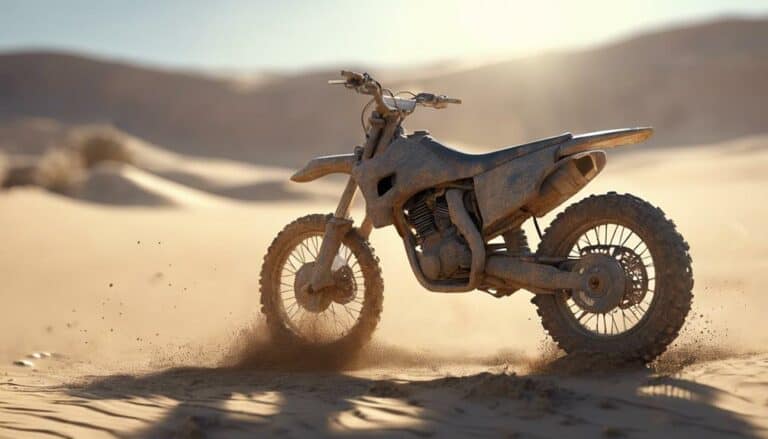Ever wondered how extreme temperatures and weather conditions can twist the fate of your dirt bike's oil changes? Well, buckle up and prepare for a ride through the impact that scorching heatwaves and icy chills can have on your engine's lifeblood.
From accelerated breakdown in sweltering heat to sluggish lubrication in freezing cold, the challenges are plenty. But worry not; there's a method to navigate this terrain and guarantee your bike's heart keeps beating strong.
Stay tuned to uncover the secrets that will keep your dirt bike running smoothly in any weather.
Key Takeaways
- Extreme temperatures impact oil viscosity and lubrication efficiency, requiring adjusted change intervals.
- Weather conditions like heat and cold affect oil degradation and flow, necessitating timely oil changes.
- Monitoring weather-related factors is crucial for optimizing engine performance and longevity.
- Regularly adapting oil change schedules based on temperature variations ensures proper engine protection.
Impact of Extreme Temperatures on Oil Change Frequency
Extreme temperature fluctuations greatly influence the frequency at which dirt bike oil changes need to be performed. When subjected to extreme temperatures, oil can break down more rapidly, altering its viscosity and reducing its lubrication efficiency.
In cold weather, oil thickens, posing challenges for engine start-up and diminishing its overall effectiveness in protecting engine components from wear and friction. Conversely, high temperatures can expedite oil degradation, compromising its ability to shield engine parts.
The impact of extreme temperatures on oil flow and circulation further affects the engine's performance and longevity, necessitating vigilant monitoring and potential adjustments to oil change intervals.
To maintain vital engine health in such conditions, it's essential to take into account the implications of extreme temperatures on oil properties and the subsequent repercussions on engine function. Regular assessment and adaptation of oil change frequencies are essential to mitigate the detrimental effects of extreme temperature environments on dirt bike engines.
Influence of Weather Conditions on Oil Change Intervals
Inclement weather conditions impact the frequency of oil changes required for the best dirt bike performance. Extreme temperatures, whether hot or cold, play a significant role in oil degradation and its ability to lubricate engine components effectively.
Hot weather can accelerate oil breakdown, reducing its lubricating properties and necessitating more frequent changes to maintain top engine health. On the other hand, cold temperatures can cause oil to thicken, affecting its flow and lubrication capabilities, potentially requiring adjustments to oil change intervals.
Additionally, high humidity levels in certain weather conditions can introduce moisture into the engine, compromising oil quality and further emphasizing the need for timely changes. Monitoring these weather-related factors and adjusting oil change intervals accordingly is important to maintain the longevity and performance of the engine oil in dirt bikes.
Adjusting Oil Change Frequency for Extreme Heat
When faced with intense heat conditions, the frequency of oil changes for your dirt bike should be adjusted to maintain peak engine performance. Extreme heat can have detrimental effects on your engine's oil, necessitating more vigilant maintenance practices. Here's what you need to take into account:
- Oil breakdown: Extreme heat can cause oil to break down faster, diminishing its ability to lubricate engine parts effectively.
- Increased oil consumption: High temperatures lead to increased oil consumption, requiring more frequent top-ups or changes to make sure proper engine lubrication.
- Oxidation process: Extreme heat accelerates the oxidation process in oil, hastening its degradation and potentially leading to engine damage.
- Oil viscosity: In hot weather, oil viscosity can decrease, impacting its capacity to protect engine components adequately.
To maintain peak engine performance and prevent potential damage, regular monitoring and adjusting oil change frequency are essential in extreme heat conditions. By staying proactive and adapting to the demands of hot weather, you can make sure your dirt bike's engine operates at its best.
Adapting Oil Change Schedule to Cold Weather
Adapting the oil change schedule to cold weather conditions is important for maintaining excellent engine performance on your dirt bike. In cold weather, engine oil thickens, which can hinder proper circulation, leading to increased engine wear and reduced lubrication. This change in oil viscosity in extreme cold conditions necessitates closer monitoring and potential adjustments to your oil change schedules to make sure performance of your dirt bike.
| Factors to Take into Account | Actions to Take |
|---|---|
| Thicker oil due to cold weather | Think about using oil designed for cold temperatures to prevent engine wear. |
| Reduced lubrication in extreme cold | Increase the frequency of oil changes to maintain proper lubrication levels. |
| Monitoring oil viscosity regularly | Check oil viscosity more frequently in cold weather to gauge effectiveness. |
Weather Effects on Dirt Bike Oil Changes
Incorporating weather considerations into your dirt bike oil change regimen is crucial for optimizing engine performance and longevity. When it comes to weather effects on dirt bike oil changes, several key factors come into play:
- Extreme temperatures can lead to rapid oil degradation, necessitating more frequent oil changes to maintain performance.
- Weather conditions, including humidity, can affect oil viscosity, influencing the frequency of oil changes required for your dirt bike.
- Temperature changes, especially rapid ones, can put stress on the oil, impacting its performance and durability.
- Hot weather can accelerate oil degradation, while cold weather can make the oil thicker, affecting its lubrication capabilities in dirt bike engines.
To make certain your dirt bike's engine runs smoothly and efficiently, it's essential to monitor weather conditions and make necessary adjustments to oil change intervals based on the specific environmental factors affecting your bike.
Conclusion
You must adapt to the ever-changing weather conditions to guarantee your dirt bike engine stays in peak condition. Extreme temperatures can cause oil breakdown or thickening, leading to frequent changes.
By monitoring and adjusting your oil change intervals based on the weather, you can protect your engine from potential damage. Stay ahead of the elements to keep your dirt bike running smoothly and efficiently.

